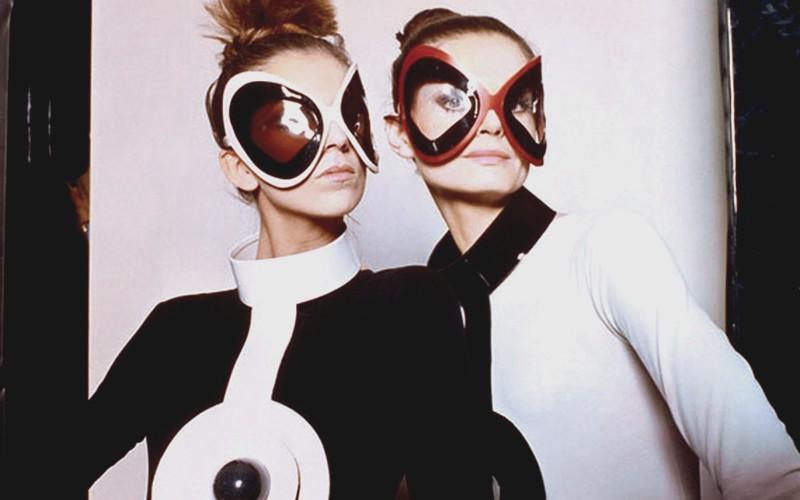Space Age: how racing in the moon influenced the fashion of 60’s
The advent of new designers...and trends
In the 1960s, if the United States and Russia engaged in a frantic race to the Moon, the small fashion microcosm also discovers a new world.Carried by details of futuristic vision such as Pierre Cardin, André Courrèges or Paco Rabanne, the borders of the universe also expand to let the ready-to-wear emerge.When in 1964 André Courrèges unveiled his "Moon Girl" collection, his straight cuts as well as his pronounced use of white (the color of the future, according to him) place his fashion in a separate category.Ultra-modern and served by accessories hitherto ever used as sunglasses and hats from another age, the look is in total opposition to the Yé-Yu-Yu which is all the rage but also very far from the modelsClassic haute couture that make the success of large houses.After this resounding beginning, the designer will also cease to transform the industry also into itself, revealing a few years later its future sewing collection, a draft of ready-to-wear as we still know it today 'Hui with its automation of creation and disappearance of personal touch -ups.
But return to style and 60’s.If Courrèges and its white boots, its little trapezoid dress, its mini-skirt and its shortcut jacket hold the attention of the time, it is not the only one.Just as inspired by space and new lifestyles (especially the conquest of the labor market by women), Pierre Cardin also endeavors to dress them for the future."Me, I am lunar ... and realistic," he reminded "Stiletto" in early 2020 when a retrospective opened in his honor in New York.This double personality served me a lot.I am obsessed with the moon, by the circles, the roundness.And I am attracted to the cosmos..The infinity of space is much more inspiring than anyone.In 1965, his Cosmos collection, inspired by astronaut Ed White, made noise.But it is all his work which can today shed light on a period in full transformation: from its bubble dress to its colored rolled passes through pants paw of revisited eph thanks to rounded legs, the Cardin fashion movesand offers women a new way of presenting themselves to a world that changes at high speed.

A reinvented woman
The common points of these two designers?Their ability to see further than the usual boundaries of style and their audacity to use new materials.But if Courrèges and Cardin dare the vinyl, the rhodoïd and the lamé, another big name of the 60's, Paco Rabanne, goes even further and present in 1966 his "12 importable dresses in contemporary materials", where metal and aluminumcreate modern and feminine armor.Mocked by Coco Chanel who nicknamed him the "metallurgist", he nevertheless imposes his futuristic style and was also chosen to dress Jane Fonda in "Barbarella" by Roger Vadim in 1968.Playing an astronaut-warrior, the actress has bras in the mesh coast and molded bodysuits to stick to an supposed plot take place in the year 4000. Hasard ou non, près de trente ans plus tard, c’est Jean-Pault Gaultier, ancien disciple de Pierre Cardin, qui sera choisi par Luc Besson pour habiller les héros futuristes du « 5ème Élément»».
Anyway, become iconic, the costumes of Paco Rabanne then bear witness to the other peculiarity which links the three designers of the 60’s: their unprecedented vision of women.Far from the convoluted cuts of haute couture but also far from the rather strict codes still in force at that time, the trio forgets the sleeves, reveals the top of the thighs and lets glimpse various parts of the body thanks to openwork parts in a completely unique way.High heels are erased and hats become external signs of style.A feminist approach?Not quite if we believe Pierre Cardin who explained in particular in the "wwd": "I was inspired by the satellites.Lasers.The moon.I saw the future.I have never been inspired by the female body.My dresses are like sculptures.I shaped them then I placed a woman there.It was more like architecture or art.»»
As for the inheritance of this futuristic past?Always alive.Forty years before the year 2000 which made them fantasize so much, these designers have delivered a vision which is still valid today.You only have to look at the last ready-to-wear collections to find certain elements that have made the Courrèges style, taken up as is or barely retouched to stick to current trends. En 2016 déjà, Arnaud Vaillant alors directeur artistique de la maison avec son binôme Sébastien Meyers confiait ses impressions sur la griffe au site « Ssense»» : « (...) The Courrèges cloakroom is so mythical, so symbolic, that we immediately wanted to focus on her flagship pieces - the miniskirt, the biker jacket, the dress - besides we found in the archives incredible things of'an unrivaled modernity.»» Même son de cloche du côté de Paco Rabanne où Julien Dossena fait réellement revivre depuis quelques saisons déjà l’esthétique féminine mais forte en caractère du fondateur.
The aerospace conquest, still as inspiring?
And contrary to what one might think, space, aliens and a certain vision of the future continue to inspire contemporary designers.In 2017, Karl Lagerfeld literally made a rocket under the canopy of the Grand Palais, under the gaze of lined up models (and the amazed eyes of the guests).More recently, in 2020, Olivier Rousteing also revealed his vision of the Space Fashion with large strokes of metallic parts and unexpected volumes, presented at a deserted airport, pandemic obliges.Between the two ?Extra-terrestrial women at Moschino, celestial creatures at Iris Van Herpen but also innovative silhouettes at Thierry Mugler.At a time when the exploration of a potential life on Mars (or elsewhere) and while space tourism is slowly but surely imposing itself as a tangible possibility, aerospace fashion still has a bright future ahead.








